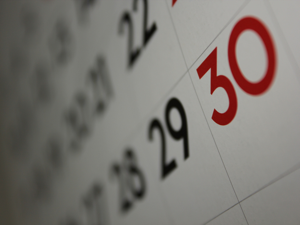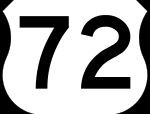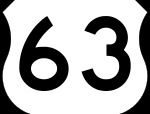 Have you practiced your multiplication by 63 skills? Good! Have you practiced your multiplication by 72 skills? Great!
Have you practiced your multiplication by 63 skills? Good! Have you practiced your multiplication by 72 skills? Great!
Today, you'll learn to put these skills to use in a surprising and amazing way!
How many seconds are there in a 365-day year? To find out, we'd multiply 365 days per year by 24 hours per day by 60 minutes per hour by 60 seconds per minute, for a grand total of 31,536,000 seconds per year.
How about the number of seconds in two consecutive 365-day years? We just multiply the previous total times 2, and we get the rather interesting total of 63,072,000 seconds in 2 years!
Since we've learned to multiply by 63 and 72 quickly, we can now use this knowledge to quickly estimate how old someone was in seconds on their last birthday!
As you've seen in the previous posts, writing down the answers as you develop them is very helpful, and is an important part of working through the feat of estimating someone's age in seconds. You should write down the answer as you go, using a writing instrument and surface which allows you to erase, such as a pencil and paper, or a dry-erase board and marker. This is because you may need to make minor corrections as you proceed.
When you start, it's important that you ask for the person's age only, and have no idea of their birthday. Since the above calculations involve multiplying by 365, leap years are not taken into consideration. As you'll see later, the emphasis should be on the speed of doing an estimate in your head, not the exactness of the answer with every detail taken into consideration.
Once you have someone's age, the first step is to divide it by 2. This is important because 63,072,000 seconds is the amount of seconds in two 365-day years. You're effectively figuring out the number of seconds in how many pairs of years there are in their age.
The person's age divided by 2 will be treated as the given number, as used in the 2 previous posts. There are 3 different kinds of challenges you'll face in this feat, and I'll explain them below from easier to more difficult.
EVEN AGES UP TO 26: If the person's age is an even number of 26 or less, this is the simplest calculation. When their age is divided by 2, the given number will also be an integer (whole number), and the skills you've developed so far will be all you need.
As an example, let's assume you ask someone their age, and the reply that their age is 26. As you write their age down at the top of the page (or board), you work out that 26 ÷d; 2 = 13, so your given number is 13.
Now, you'll be effectively multiplying 13 by 63 million instead of 63, so I start by putting down a comma. To the immediate left of this comma will be the millions, and to the immediate right will be the hundred-thousands place. So far, the writing surface would look like this (not including the age at the top):
,
Now, we work through our process for multiplying by 63: “13 tripled is 39...*write down the 9 to the immediate left of the comma*...39 doubled is 78...78 plus 3 is 81...*write down the 81 to the immediate left of the 9*...” Before we move on to the multiplication by 72, let's take a look at the writing surface as it would look now:
819,
Remember, this represents 756 million at this point. The places are important, of course. The next step is to multiply by 72,000, which means putting down another comma to the right of the above answers, and putting dow the comma between the thousands and hundreds place (dashes used to represent empty spaces):
819,---,
From here, you continue your calculations to multiply by 72, picking up from where you left off: “78 doubled is 156...*write down the 6 to the immediate left of the comma*...78 plus 15 is 93...*write down the 93 to the immediate left of the 6*...” At this point, you should have an answer which appears like this:
819,936,
The final step is always to write 3 zeroes to the right of the rightmost comma:
819,936,000
Sure enough, if you have a person multiply their age, 26 in this example, by 365 by 24 by 60 by 60, they'll find that 819,936,000 is the right answer!
Even better, that's the process they'll assume you went through in your head to get your answer, so you're getting credit for doing the full work, when you're really only using a short cut.
EVEN AGES FROM 28 to 66: Ages ranging from 28 to 66 will result in given numbers being integers ranging from 14 to 33. When multiplied by 72, any of these numbers are over 1,000. This means, of course, that when multiplied by 72,000, these numbers will result in answers of 1 million or more, so you'll have to deal with carrying that 1 over into the answer you received when multiplying by 63.
For this example, let's say the person's age is 42, which makes the given number 21.
Start running through the process as before, thinking and writing as you go: “21 tripled is 63...*write down the 3 to the immediate left of the comma*...63 doubled is 126...126 plus 6 is 132...*write down 132 to the immediate left of the 3, include comma to denote 1 billion, add in comma before thousands place*...” So far, you would have this:
1,323,---,
Continuing on to multiply by 72, you'd think and write, “126 doubled is 252...*write down the 2 to the immediate left of the comma*...126 plus 25 is 151...*write down 151 to the left of the 2*...” Here's where you run into the challenge. As you start to write the 151 to the left of the 2, you realize there's going to be overlap. Write the tens and ones digit of 151 (the 5 and rightmost 1) as you would normally, like this:
1,323,512,
Next, erase the 3 and mentally add 1 to it, giving 4. So, you replace the 3 with a 4, and the answer will look like this:
1,324,512,
Don't forget to add the 3 zeroes to the right of the rightmost comma, so you have the full answer:
1,324,512,000
Dealing with carrying seems tricky at first, but once you get the hang of it, it's not much of an obstacle.
ODD AGES UP TO 65: Odd ages will result in a given number ending in .5, as you've seen in the previous tutorials. When dealing with these numbers, you may have to deal with carrying, as above, but you'll have to make 2 more simple adjustments.
The first, of course, is writing “&,5#148; instead of “.5”. When you're only multiplying by 63, the number just represents .5, but when multiplying by 63 million, that .5 starts representing 500,000! I'll discuss the other adjustment when we come to it.
For this example, we'll say that the person is 35, which, when divided by 2, makes your given number 17.5.
You would start just as before: “17.5 tripled is 51...52.5...*write down the 2,5*...52.5 doubled is 105...105 plus 5 is 110...*write down 110 to the immediate left of the 2,5, add comma for thousands*...” So far, you have:
1,102,5--,
At this point, you can probably see the other problem coming. Not only will you have to carry as before, but you now have to deal with that 500,000. Don't worry, this is easy to solve. When you're working out the final addition for the multiplication by 72, mentally add 50 to it. Once you have this number, erase the 5, and write the total as you would before. If needed, use the carrying technique taught earlier.
Continuing with our example from where we left off: “105 doubled is 210...*write down the 0 to the immediate left of the comma*...105 plus 21 is 126...126 plus 50 (to deal with the 500,000) is 176...*erase the 5, write down the 76, erase the 2, add 1 for the carry, write 3 and final zeroes*” Your final answer, with the 3 zeroes should look like this:
1,103,760,000
Yes, this is the correct answer for 35 × 365 × 24 × 60 × 60.
Once you become familiar with both carrying and dealing with ages of an odd number, you're ready to handle any age up to 66 in this feat!
TIPS:• You can use this link to practice with even ages only, and then use this link to practice with any age from 1 to 66. Don't forget to check your answer with this link, setting x to the age you were given (default age at the link is 42).
• After going through the calculation, I like to explain, “I only asked for the age, so I have no idea if the birthday they're talking about was last year, this year, or even next year. So, instead of trying to take every last detail such as leap years or seconds since their birthday into account, this is just a quick mental estimate.” They'll be startled to find out that this estimate is so exact, when you explain that you're multiplying their age by 365 days in a year, by 24 hours in a day, by 60 minutes in an hour, and by 60 seconds in a minute!
• You can grab interest at the beginning by talking about how people hear the terms million and billion, but never really think of the difference. Explain that 1 million seconds is only about 111⁄2 days, while 1 billion seconds is roughly 312⁄3 years!
If you know you're going to be performing this feat ahead of time, you can use Wolfram|Alpha's calculations and Wikipedia's year and month pages to find historical events you could mention. It's one thing to say that 1 billion seconds ago was December 1981, but more vivid to say something like 1 billion seconds ago, Britney Spears was born.
Practice this feat and have fun using it to amaze people!

 There's a book out called The Mental Calculator's Handbook by Jan van Koningsveld and Robert Fountain, which naturally piqued my interest just by the title.
There's a book out called The Mental Calculator's Handbook by Jan van Koningsveld and Robert Fountain, which naturally piqued my interest just by the title.










